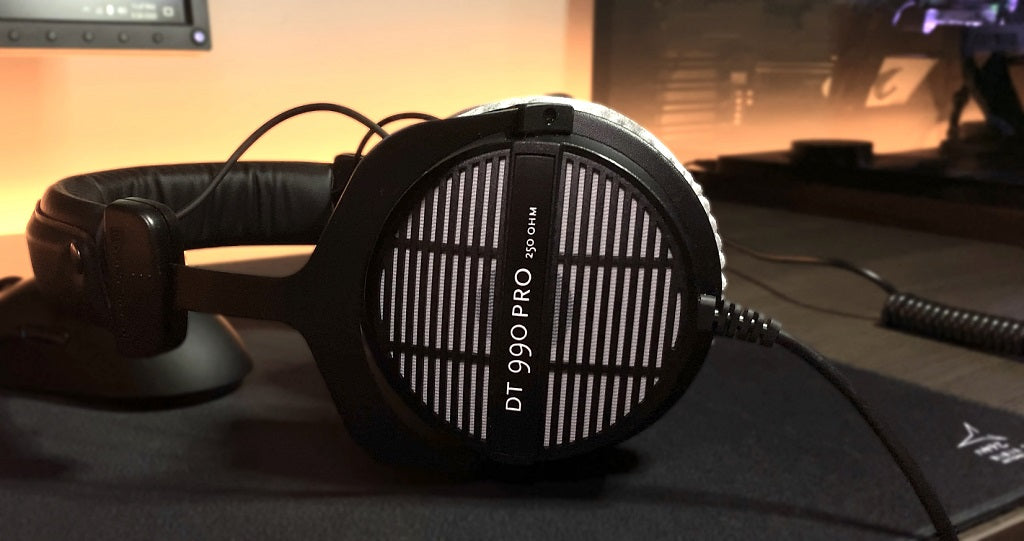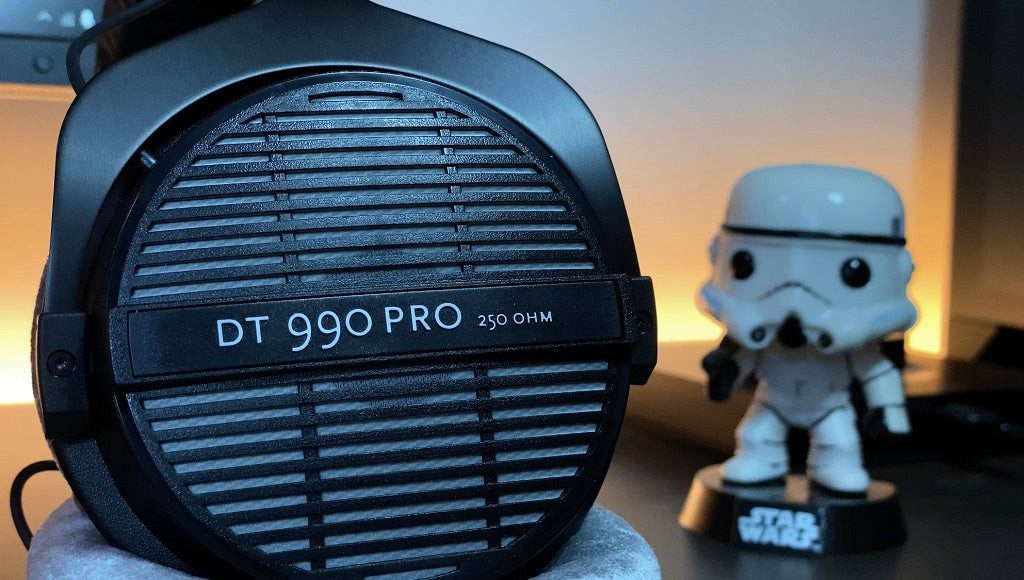How Easy is It to Drive Dt990
As the title suggests, this review is for the Beyerdynamic DT 990 Pro – the 250 ohm model to be precise. The DT 990 Pro has been around for decades, and has seen very little change in its design. The only changes it has seen have been almost purely cosmetic. I noticed that these were on sale for $129 and given their love/hate reputation, I was simply itching to give these a try. I tested these for the better part of last week, and now that I have given them a good shake, I think they are ready for a proper review.
Sources and Music Used in Listening Tests
The Amplifier/DAC used in this review was theJDS Labs ElementII connected via USB to my desktop computer. For the listening tests I used a variety of music that featured genres like Rock, Jazz, Classical, Acoustic, Hip-Hop, and latin, as well as others. These were played from either my own FLAC library, or from Tidal (HiFi/Master Quality).
Power Requirements
The DT 990 Pro, without a doubt, requires an amp. These come in at an impedance of 250 ohms and a sensitivity of 99dB. This is the first headphone that actually required me to set my amplifier (JDS Labs ElementII) to High-Gain. The Sennheiser HD 6XX was actually easier to drive than these, and so was the DT 1990 Pro. I think if you are interested in these, you will definitely need a fairly powerful amp if you want to drive these well.

Build Quality and Comfort
This is Beyerdynamic's time-tested design we are talking about here, and it is easy to understand why it has not seen any real structural changes in the last 30 years. I have other Beyerdynamic headphones with this design, and I have never had any issues pertaining to their longevity. They are extremely lightweight (249g), but are as rigid as tanks. Additionally almost everything on these is replaceable, with spare parts available for purchase via Beyerdynamic's website. Only drawback in the build is the non-detachable cable; if something happens to it, you gotta replace the entire unit.
The comfort on these is spectacular, these are basically ear pillows. The velour earpads that Beyerdynamic uses on these is simply fantastic. When you combine these amazing earpads with the extremely light weight, and the low clamp force, you get one of the most comfortable headphones out there–it is sincerely easy to forget you are wearing them!
Sound
While the build and comfort is great out of the box, I am afraid the same cannot be said for the sound. I would describe these as "aggressive." Now, that is not the most descriptive way of walking you through how these sounds, so as per usual I will be breaking sound into Bass, Mids, and Treble. Along the way I will also be discussing how these sound with EQ, as they actually respond decently to adjustments.
Bass
The bass here has some pretty significant roll-off starting at around 50hz. Despite that, the bass to me comes across as fairly forward, likely due to the elevation it has at around 150hz. To my taste, it makes the bass sound a little bit bloated, and I think it undermines the DT 990 Pro's ability to reproduce bass. Still, I would say that the bass extension and detail here is better than that in the HD 6XX and HD 58X–also worth mentioning that the DT 990 far surpasses them in bass dynamics, as these pack quite the punch.
When I use EQ on the DT 990, I like to add a low shelf of 2dB at 50hz. I also fix the elevation at 150hz by adding a fairly narrow dip of -4dB. These fairly minor adjustments significantly clean up the bass, and alleviate some of that roll-off. After EQ the bass here is actually very good, especially when comparing them to other headphones in the sub $200 price range, and even some above it.
Mids
The mids on the DT 990 are actually pretty good. They are very fast and detailed, especially for the price you can find them at nowadays. The tonality is not that bad either, but it does have some issues. There is a very noticeable dip at around 700hz that sucks out the body of vocals and a lot of other instruments that are very present in the lower mids. Additionally, the upper mids come across as a little forward, by about 2dB. Additionally, the timbre is fairly off, and metallic sounding.
The mids on the DT 990 respond well to EQ, but it definitely does not work miracles. The dip in the lower mids is resolved almost completely, and so is the slight elevation at 3k. While it does make the mids sound slightly more natural, it does not really fix the metallic timbre–it does so very slightly. Once again, I would like to give these credits for their outstanding resolution in the mids. However, in tonality and timbre, they do not even get close to what both the HD 6XX and HD 58X are capable of.
Treble
There is too much of it.
Ok, so obviously the DT 990 are a bright headphone, but even in terms of brightness they redefine "to infinity and beyond!" The treble extension is actually pretty decent, but there are three very significant peaks that make these headphones piercing to listen to. There is a narrow, and extreme peak at 6k that adds significant glare. Then there is another massive peak at 8.5k that adds severe levels of sibilance, and makes instruments which overtones fall in this range come across as very harsh. The last peak is around 13k, and it adds this strange sort of ringing. Lastly, I think the frequencies above 10k have a little too much energy. Altogether, I think that this excess in treble, not only makes the headphones fatiguing and sound like they are sizzling, but also accentuates the DT 990's metallic timbre.
Fixing the treble requires quite a few and very drastic adjustments. I use peak filters at 6k, 8.5k, and 13k. At 6k I add a narrow -10dB dip, which eliminates most of the glare. The peak I use at 8.5k is even narrower, and more aggressive; reducing that peak by 11dB. The last peak adjustment is again a narrow -7dB dip at 13k that gets rid of the ring-like sound I hear there. I also like to add a -1.5dB high shelf starting at 14k, just to tone down some of that sizzle-like quality. Once the treble is fixed I would say that their resolution is actually pretty good. They have less grain than the HD 58X, but still lag behind the HD 6XX in terms of treble resolution.

Sound Stage and Imaging
This is an area where the DT 990 really shines. I have a hard time thinking of another headphone close to its price point that has as wide a soundstage as the DT 990. The soundstage in these is simply fantastic; very open and spacious. The imaging on the DT 990 is also great, and very precise. The instrument separation here is also very good, at least on par with the HD 6XX in that.
Dynamics
I think that the DT 990 has some of the best dynamics under $200. The bass have a fantastic sense of punch and slam. Microdynamics are also pretty decent as well. They do a fairly good job of recreating the presence and dynamic of instruments. By this I mean that they do a good job at recreating how soft or hard instruments are being played. For example, you can feel the attack behind piano keystrokes, and palm mutes on guitars.
EQ
I have mentioned EQ throughout this review, but I would like to briefly discuss the sound after EQ as a whole. Once the EQ is applied in its entirety, the DT 990 Pro's cool down quite a bit. They are still bright, mind you, but a lot more enjoyable and close to my personal FR target. The bass is a lot more refined with EQ, and while it does not have incredible extension, it is very well-defined. The mids see significant improvement, as it gives them a more natural, less forward tonality whilst alleviating some of the timbre issues. The highs, unfortunately, retain a little bit of their sizzle, but they see great improvement nonetheless; they are no longer painful or fatiguing to listen to. If you want to try my EQ, you can input it into your EQ software of choice as follows:
- Low Shelf at 50hz, +2dB Q of 0.7
- Peak at 150hz, -4dB Q of 2.41
- Peak at 700hz, +3dB Q of 2
- Peak at 3000hz, -3dB Q of 1.8
- Peak at 6000hz, -10dB Q of 4
- Peak at 8500hz, -11dB Q of 4
- Peak at 13000hz, -7dB Q of 6
- High Shelf at 14000hz, -1.5dB Q of 7

Conclusion
Unfortunately, without EQ, the DT 990 Pro's are a tough listen. The bass and mids have good resolution and a generally agreeable tonality, but the treble really is piercing. It is not because the DT 990 are bright, as there are headphones like the HiFiMan Sundara that lean towards bright but are quite smooth in the highs. It is because they are excessively bright in spots that can quickly become fatiguing to listen to.
However, I must say that these might be the ultimate gaming headphones. The DT 990's pristine imaging and wide soundstage lend themselves well to usage in competitive online shooters. Funny enough, their default FR actually does an outstanding job at isolating footsteps and gunfire from the rest of game mixes. If you already have a discrete microphone (or if you use a mod mic), you could get these as a serious upgrade to your gaming audio regardless of the price range you look at.
Review written by @Chrono
Check out the video review here:
---Join the discussion about the Beyerdynamic DT-990 Pro at "The HEADPHONE Community". ---
Source: https://headphones.com/community/reviews-learning-and-news/beyerdynamic-dt-990-pro-250-ohm-review-budget-gaming-headphones
0 Response to "How Easy is It to Drive Dt990"
Publicar un comentario